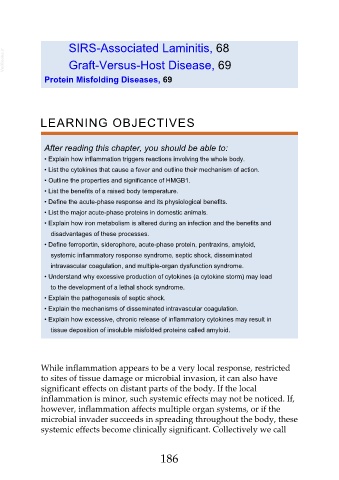Page 186 - Veterinary Immunology, 10th Edition
P. 186
SIRS-Associated Laminitis, 68
VetBooks.ir Graft-Versus-Host Disease, 69
Protein Misfolding Diseases, 69
LEARNING OBJECTIVES
After reading this chapter, you should be able to:
• Explain how inflammation triggers reactions involving the whole body.
• List the cytokines that cause a fever and outline their mechanism of action.
• Outline the properties and significance of HMGB1.
• List the benefits of a raised body temperature.
• Define the acute-phase response and its physiological benefits.
• List the major acute-phase proteins in domestic animals.
• Explain how iron metabolism is altered during an infection and the benefits and
disadvantages of these processes.
• Define ferroportin, siderophore, acute-phase protein, pentraxins, amyloid,
systemic inflammatory response syndrome, septic shock, disseminated
intravascular coagulation, and multiple-organ dysfunction syndrome.
• Understand why excessive production of cytokines (a cytokine storm) may lead
to the development of a lethal shock syndrome.
• Explain the pathogenesis of septic shock.
• Explain the mechanisms of disseminated intravascular coagulation.
• Explain how excessive, chronic release of inflammatory cytokines may result in
tissue deposition of insoluble misfolded proteins called amyloid.
While inflammation appears to be a very local response, restricted
to sites of tissue damage or microbial invasion, it can also have
significant effects on distant parts of the body. If the local
inflammation is minor, such systemic effects may not be noticed. If,
however, inflammation affects multiple organ systems, or if the
microbial invader succeeds in spreading throughout the body, these
systemic effects become clinically significant. Collectively we call
186

